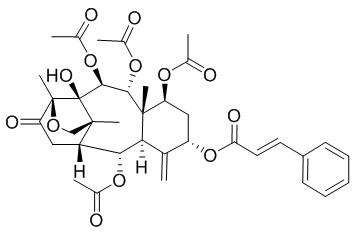Taxagifine
Taxagifine shows cytotoxic activity toward HepG2 cells; it can suppress the superoxide generation induced by N-formyl-methionyl-leucyl-phenylalanine (fMLP) and arachidonic acid (AA) in a concentration-dependent manner.
Inquire / Order:
manager@chemfaces.com
Technical Inquiries:
service@chemfaces.com
Tel:
+86-27-84237783
Fax:
+86-27-84254680
Address:
1 Building, No. 83, CheCheng Rd., Wuhan Economic and Technological Development Zone, Wuhan, Hubei 430056, PRC
Providing storage is as stated on the product vial and the vial is kept tightly sealed, the product can be stored for up to
24 months(2-8C).
Wherever possible, you should prepare and use solutions on the same day. However, if you need to make up stock solutions in advance, we recommend that you store the solution as aliquots in tightly sealed vials at -20C. Generally, these will be useable for up to two weeks. Before use, and prior to opening the vial we recommend that you allow your product to equilibrate to room temperature for at least 1 hour.
Need more advice on solubility, usage and handling? Please email to: service@chemfaces.com
The packaging of the product may have turned upside down during transportation, resulting in the natural compounds adhering to the neck or cap of the vial. take the vial out of its packaging and gently shake to let the compounds fall to the bottom of the vial. for liquid products, centrifuge at 200-500 RPM to gather the liquid at the bottom of the vial. try to avoid loss or contamination during handling.
Aging (Albany NY).2021, 13(19):22867-22882.
Phytochemistry.2017, 141:162-170
ACS Pharmacol. Transl. Sci.2023, 3c00129.
Sci Adv.2018, 4(10)
J Ethnopharmacol.2019, 241:112025
Front Immunol.2023, 14:1240800.
J Pharmaceutical Research Int.2021, 33(41A):275-284.
Int J Mol Sci.2024, 25(18):9909.
J of the Korean Society of Food Science and Nutrition2019, 32(2):148-154
Food Chem.2019, 276:768-775
Related and Featured Products
Journal of Wood Science, 2008, 54(5):390-401.
The polar neutral and basic taxoids isolated from needles and twigs of Taxus cuspidata and their biological activity[Reference:
WebLink]
METHODS AND RESULTS:
Twelve basic taxoids and 22 neutral taxoids were isolated from basic and polar neutral fractions of the extracts of needles and twigs of Taxus cuspidata. Among them, taxine NA-13, 3,11-cyclotaxinine NN-1, taxinine NN-6, 11(15[rightward arrow]1)abeo-taxinine NN-1, taxine NA-8, and taxine NA-4 were isolated first from natural sources by us. The cytotoxic activity of isolated compounds was evaluated against three human cell lines: normal human fibroblast cells (WI-38), malignant tumor cells induced from WI-38 (VA-13), and human liver tumor cells (HepG2).
CONCLUSIONS:
7-Epitaxol, 7-epicephalomannine, taxinine NN-6, taxine NA-2, taxuspine H, and Taxagifine were active toward VA-13 cells and 7-epitaxol, 7-epicephalomannine, taxinine NN-1, 9,10-deacetyltaxinine, and Taxagifine were active toward HepG2 cells.
Planta Med. 2009 Jun;75(8):814-22.
Effect of seven tricyclic diterpenoids from needles of Taxus media var. Hicksii on stimulus-induced superoxide generation, tyrosyl or serine/threonine phosphorylation and translocation of cytosolic compounds to the cell membrane in human neutrophils.[Pubmed:
19288401 ]
Taxol has been widely used as an anticancer drug for ovarian, breast, lung and prostate cancer. Some kinds of Taxus plants are widely distributed in the Northeast Asia region.
METHODS AND RESULTS:
We have isolated seven tricyclic diterpenoids, taxinine, Taxagifine, 5-O-cinnamoyltaxacin I triacetate, 5-decinnamoyltaxinine J, 5-cinnamoyl-9-acetyltaxicin I, taxacin and taxol from the needles of Taxus media var. Hicksii, and investigated their effects on stimulus-induced superoxide generation and translocation of cytosolic compounds to the cell membrane in human neutrophils. Six tricyclic diterpenoids used in this experiment suppressed the superoxide generation induced by N-formyl-methionyl-leucyl-phenylalanine (fMLP) and arachidonic acid (AA) in a concentration-dependent manner. Taxinine significantly suppressed the superoxide generation induced by phorbol 12-myristate 13-acetate (PMA).
CONCLUSIONS:
The compounds also suppressed fMLP- and AA-induced tyrosyl or PMA-induced serine/threonine phosphorylation, and translocation of cytosolic compounds, p47 (phox), p67 (phox) and Rac to the cell membrane in parallel with the suppression of the stimulus-induced superoxide generation.



